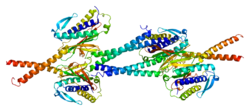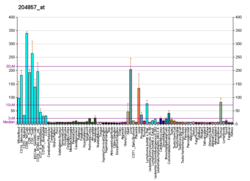Mitotic spindle assembly checkpoint protein MAD1 is a protein that in humans is encoded by the MAD1L1 gene.[5][6][7]
MAD1L1 is also known as Human Accelerated Region 3. It may have played a key role in the evolution of humans from apes.[8]
Function edit
MAD1L1 is a component of the mitotic spindle-assembly checkpoint that prevents the onset of anaphase until all chromosome are properly aligned at the metaphase plate. MAD1L1 functions as a homodimer and interacts with MAD2L1. MAD1L1 may play a role in cell cycle control and tumor suppression. Some studies indicate associations of MAD1L1 with psychiatric disorders, including schizophrenia, bipolar disorder, and depression. [9][10][11] Three transcript variants encoding the same protein have been found for this gene.[7]
Interactions edit
MAD1L1 has been shown to interact with:
See also edit
References edit
- ^ a b c GRCh38: Ensembl release 89: ENSG00000002822 – Ensembl, May 2017
- ^ a b c GRCm38: Ensembl release 89: ENSMUSG00000029554 – Ensembl, May 2017
- ^ "Human PubMed Reference:". National Center for Biotechnology Information, U.S. National Library of Medicine.
- ^ "Mouse PubMed Reference:". National Center for Biotechnology Information, U.S. National Library of Medicine.
- ^ Jin DY, Kozak CA, Pangilinan F, Spencer F, Green ED, Jeang KT (February 1999). "Mitotic checkpoint locus MAD1L1 maps to human chromosome 7p22 and mouse chromosome 5". Genomics. 55 (3): 363–364. doi:10.1006/geno.1998.5654. PMID 10049595.
- ^ Jin DY, Spencer F, Jeang KT (April 1998). "Human T cell leukemia virus type 1 oncoprotein Tax targets the human mitotic checkpoint protein MAD1". Cell. 93 (1): 81–91. doi:10.1016/S0092-8674(00)81148-4. PMID 9546394. S2CID 7345931.
- ^ a b "Entrez Gene: MAD1L1 MAD1 mitotic arrest deficient-like 1 (yeast)".
- ^ Kostka D, Hubisz MJ, Siepel A, Pollard KS (March 2012). "The role of GC-biased gene conversion in shaping the fastest evolving regions of the human genome". Molecular Biology and Evolution. 29 (3): 1047–1057. doi:10.1093/molbev/msr279. PMC 3278478. PMID 22075116.
- ^ Lam M, Chen CY, Li Z, Martin AR, Bryois J, Ma X, et al. (December 2019). "Comparative genetic architectures of schizophrenia in East Asian and European populations". Nature Genetics. 51 (12): 1670–1678. doi:10.1038/s41588-019-0512-x. PMC 6885121. PMID 31740837.
- ^ Hou L, Bergen SE, Akula N, Song J, Hultman CM, Landén M, et al. (August 2016). "Genome-wide association study of 40,000 individuals identifies two novel loci associated with bipolar disorder". Human Molecular Genetics. 25 (15): 3383–3394. doi:10.1093/hmg/ddw181. PMC 5179929. PMID 27329760.
- ^ Sokolov AV, Manu DM, Nordberg DO, Boström AD, Jokinen J, Schiöth HB (January 2023). "Methylation in MAD1L1 is associated with the severity of suicide attempt and phenotypes of depression". Clinical Epigenetics. 15 (1): 1. doi:10.1186/s13148-022-01394-5. PMC 9811786. PMID 36600305.
- ^ a b Yoon YM, Baek KH, Jeong SJ, Shin HJ, Ha GH, Jeon AH, et al. (September 2004). "WD repeat-containing mitotic checkpoint proteins act as transcriptional repressors during interphase". FEBS Letters. 575 (1–3): 23–29. doi:10.1016/j.febslet.2004.07.089. PMID 15388328. S2CID 21762011.
- ^ Rual JF, Venkatesan K, Hao T, Hirozane-Kishikawa T, Dricot A, Li N, et al. (October 2005). "Towards a proteome-scale map of the human protein-protein interaction network". Nature. 437 (7062): 1173–1178. Bibcode:2005Natur.437.1173R. doi:10.1038/nature04209. PMID 16189514. S2CID 4427026.
- ^ Sironi L, Melixetian M, Faretta M, Prosperini E, Helin K, Musacchio A (November 2001). "Mad2 binding to Mad1 and Cdc20, rather than oligomerization, is required for the spindle checkpoint". The EMBO Journal. 20 (22): 6371–6382. doi:10.1093/emboj/20.22.6371. PMC 125308. PMID 11707408.
- ^ Murakumo Y, Roth T, Ishii H, Rasio D, Numata S, Croce CM, Fishel R (February 2000). "A human REV7 homolog that interacts with the polymerase zeta catalytic subunit hREV3 and the spindle assembly checkpoint protein hMAD2". The Journal of Biological Chemistry. 275 (6): 4391–4397. doi:10.1074/jbc.275.6.4391. PMID 10660610.





